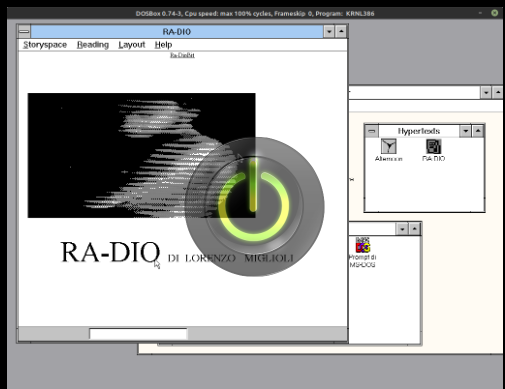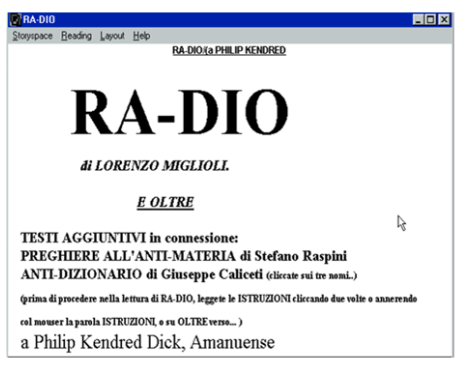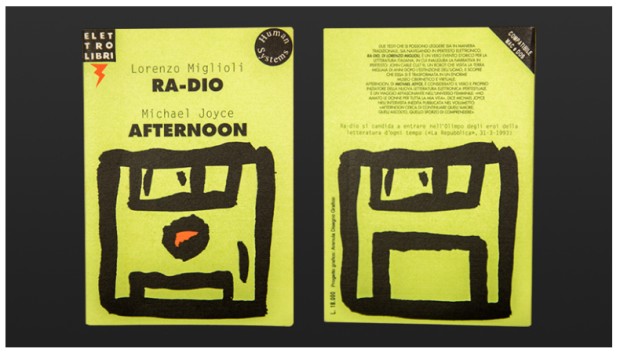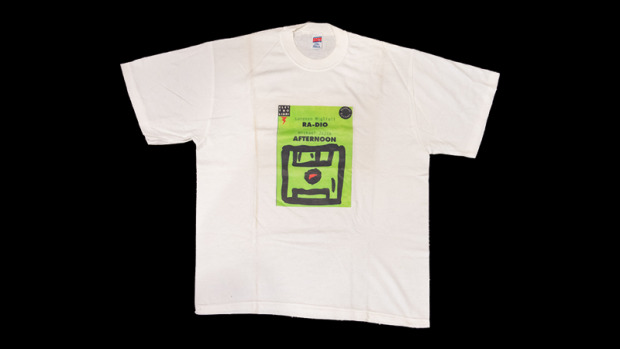RA-DIO
Ra-Dio was the first Italian narrative hypertext. Made by Lorenzo Miglioli (already author of experimental texts for various media, from television, to cinema, to theater), Ra-Dio was published in May 1993 in the Elettrolibri series, a co-edition between the Castelvecchi (Rome) and Synergon publishing houses (Bologna), with the technical contribution of the Milanese group Human Systems.
As evidence of the historical transition period, Ra-Dio was presented in two versions: a paper version, in the form of a booklet with a green cover, and a digital version, in the form of a 1.44 Mb floppy disk (to be precise, the floppies were two: one compatible with DOS and one compatible with Mac. Besides, the floppies were attached to the paper publication).
The 90-pages booklet contained some extracts from Ra-Dio and Bit Generation, another short story written by Miglioli, and an interview with Michael Joyce. The latter was the author of the first hypertextual electronic novel ever published, afternoon, a story (1987), as well as the co-creator of Storyspace, the hypertextual writing and reading platform with which both Ra-Dio and afternoon itself were made.
Each floppy disk contained the first Italian translation of Joyce's novel (edited by Alearda Pandolfi, Filippo Soresi and Walter Vannini) and Ra-Dio, naturally, in a largely reworked version compared to the paper version, both because it exploited the potential of electronic medium, and because it interacted with other texts (Bit Generation and other short stories written in co-production with Stefano Raspini and Giuseppe Caliceti, founding members, together with Miglioli, of the literary research group I.E.N. Ipermarket Emilia Nord).
Visionary, caustic, provocative, Ra-Dio is indeed a tale of dystopian science fiction - together with the technowarrior John Cable Cult III we discover that humanity has been extinct for thousands of years and the Earth has become an immense virtual museum - but it is also above all, an artistic intervention born from the awareness of the evolution of literature: Miglioli, in fact, described the digital version as a "ready made" of the new literature in mutation, a virus not to be freed by opening the file that contained it (and, as such, Ra-Dio was exhibited in an avant-garde collective at the Center Pompidou in Paris, in 1995).
Miglioli's artistic-conceptual operation generated an enormous media impact: interest in hypertextual literature exploded in Italy, Ra-Dio sold over twenty thousand copies and its author became a cult author for an entire generation.
The original edition is practically impossible to find, but it is possible to interact with an archival version faithful to the original published in September 2023 on archive.org, thanks to the joint effort of some collectives and institutions involved in preserving and studying the history of technology, culture and digital society: MIAI (Interactive Museum of Computer Archaeology), MusIF (Museum of Functioning Informatics), and LEI (Italian Electronic Literature) group.
Ra-Dio è stato il primo ipertesto narrativo italiano. Realizzato da Lorenzo Miglioli – già autore di testi sperimentali per diversi media, dalla televisione, al cinema, al teatro – Ra-Dio fu pubblicato nel maggio 1993 all'interno della collana Elettrolibri, una coedizione tra le case editrici Castelvecchi (Roma) e Synergon (Bologna), con il contributo tecnico del gruppo milanese Human Systems.
A testimonianza del periodo storico di transizione, Ra-Dio venne presentato in due versioni: cartacea, sotto forma di un libretto dalla copertina verde, e digitale, sotto forma di floppy disk da 1.44 Mb (per la precisione, i floppy – forniti in allegato alla pubblicazione cartacea – erano due: uno compatibile con DOS e uno compatibile con Mac).
Il libretto, di 90 pagine, conteneva degli estratti di Ra-Dio e di Bit Generation, un altro breve racconto realizzato da Miglioli, e un'intervista a Michael Joyce, autore del primo romanzo elettronico ipertestuale mai pubblicato, afternoon, a story (1987), nonché co-ideatore di Storyspace, la piattaforma di scrittura e lettura ipertestuale con la quale vennero realizzati sia Ra-Dio che lo stesso afternoon.
I floppy disk contenevano, ciascuno, la prima traduzione italiana del romanzo di Joyce (curata da Alearda Pandolfi, Filippo Soresi e Walter Vannini) e Ra-Dio, naturalmente, in una versione ampiamente rimaneggiata rispetto a quella cartacea, sia perché sfruttava le potenzialità del medium elettronico, sia perché interagiva con altri testi (Bit Generation e altri brevi racconti scritti in coproduzione con Stefano Raspini e Giuseppe Caliceti, membri fondatori, insieme a Miglioli, del gruppo di ricerca letteraria I.E.N. Ipermarket Emilia Nord).
Visionario, caustico, provocatorio, Ra-Dio è sì un racconto di fantascienza distopica – assieme al tecnoguerriero John Cable Cult III si scopre che l'umanità si è estinta da migliaia di anni e la Terra è diventata un immenso museo virtuale – ma è anche, soprattutto, un intervento artistico nato dalla consapevolezza dell'evolversi della letteratura: Miglioli, infatti, descrisse il dischetto come un “ready made” della nuova letteratura in mutazione, un virus da non liberare aprendo il file che lo conteneva (e, come tale, venne esposto nel 1995 al Centre Pompidou di Parigi in una collettiva d'avanguardia).
L’operazione artistico-concettuale di Miglioli generò un enorme impatto mediatico: in Italia esplose l'interesse per la letteratura ipertestuale, Ra-Dio vendette oltre ventimila copie e il suo autore divenne un autore di culto per un'intera generazione.
Mai più ripubblicato, oggi Ra-Dio è praticamente introvabile... Finora.
A distanza di 30 anni, il primo ipertesto narrativo italiano è di nuovo disponibile su archive.org in una versione archivistica interattiva e fedele all’originale, grazie allo sforzo congiunto di alcuni collettivi e istituzioni che si occupano di conservare e studiare la storia della tecnologia, della cultura e della società digitale: i musei MIAI (Museo Interattivo di Archeologia Informatica) di Cosenza e MusIF (Museo dell’Informatica Funzionante) di Palazzolo Acreide, e il gruppo LEI (Letteratura Elettronica Italia).








